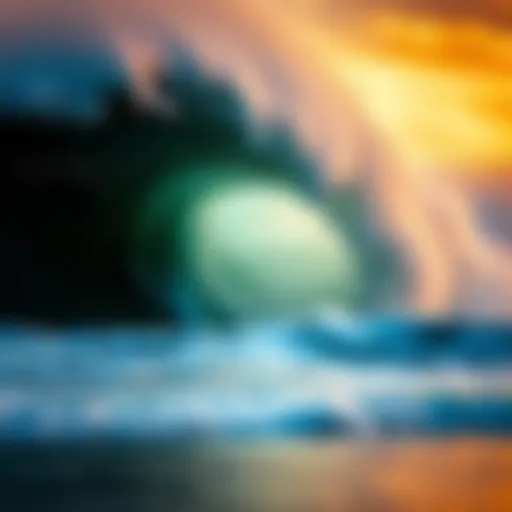Understanding the Causes of Swell in Surfing
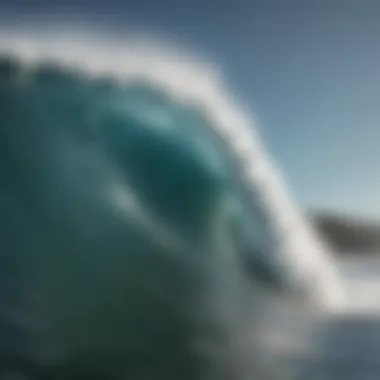

Intro
Swell is an essential concept that forms the backbone of the surfing experience. Understanding its causes not only aids surfers in catching better waves but also enhances their overall connection to the ocean. Swell does not come from the same source every time; it is shaped by various elements, including wind patterns, ocean floor topography, and even the atmospheric conditions far from the coastline.
For surfers, this knowledge is not merely academic. Grasping the dynamics of swell can drastically improve their performance and decision-making when hitting the waves. Knowing when and where swell will hit can mean the difference between a spectacular ride or a mediocre session.
To help clarify these concepts, we will wander through the intricate world of swell, breaking down its origins and types. This exploration will encompass everything from how distant storms generate waves to how local winds influence surf quality.
Let’s dive in and see just what makes those waves roll in!
Surfboard Reviews
When it comes to riding the swell, the equipment you choose can make a world of difference. The type of surfboard you ride should align with your skill level and the kind of waves you're looking to tackle.
Types of Surfboards: An Overview
Surfboards come in various shapes and sizes, each designed for specific conditions and styles.
- Shortboards: Typically around 5'5" to 6'6" in length, these boards are perfect for high-performance surfing.
- Longboards: Usually 9 feet or longer, these provide stability and easier paddling, ideal for beginners or those who enjoy a laid-back style.
- Fish: Characterized by a wider nose and a shorter length, they handle smaller, weaker waves well.
- Funboards: A blend between longboards and shortboards, they offer versatility for different wave conditions.
Best Surfboards for Beginners and Pros
Choosing the right board can make or break your experience. For those just starting out, consider these options:
- Soft-top Boards: These are forgiving and safe, making them great for newbies.
- Minimalibu: An excellent middle-ground board that balances performance and stability.
For the pros aiming to tackle bigger swells, top choices might include:
- High-Performance Shortboards: Designed for agility and speed on bigger waves.
- Step-Up Boards: These are meant for larger surf, offering extra paddle power and maneuverability.
"The right surfboard is like a tailored suit; it makes all the difference in how you feel on the water."
Understanding these variations in surfboards aids surfers in making informed decisions tailored to their preferences and conditions.
Surfing Techniques
Mastering the techniques associated with surfing takes practice, but knowing the basics can help you jump right in.
Essential Techniques for Beginners
- Paddling: Proper paddling technique allows you to catch swells more effectively. Keep your arms at a 90-degree angle and engage your core.
- Pop-Up: The maneuver to stand on the board emerges from a strong push-up position. Quickness is key.
- Turtle Roll: For beginners navigating small surf, this technique helps get over waves when paddling out.
Advanced Maneuvers for Experienced Surfers
Once you’ve gained confidence, consider refining your skills:
- Bottom Turn: A crucial move that sets up your ride down the line. Angle your board on the bottom of the wave to gain speed.
- Cutback: This maneuver lets you redirect back towards the breaking part of the wave, maintaining speed while carving expertly.
In the realm of surfing, understanding not just the mechanics of the sport but also the environmental conditions that create the ideal swell can elevate your performance to the next level. By recognizing these connections, surfers can ride the waves with newfound confidence and skill.
Prelims to Swell Dynamics
Swell dynamics form the very backbone of surfing, intertwining with the rhythm of waves and defining the experience for surfers. To grasp swell dynamics, surfers must consider numerous facets that contribute to wave formation. This understanding is not merely an academic endeavor; it's a key factor in choosing when and where to surf. Knowing the mechanics behind swell can elevate a surfer’s confidence and competence on the water.
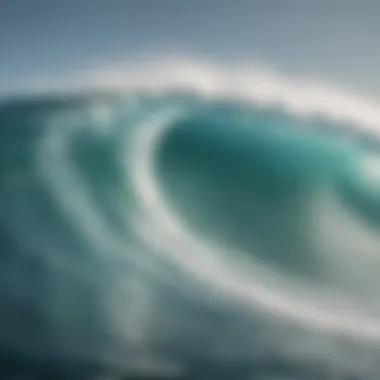

Swell refers to the series of waves that have traveled out from their point of generation, and comprehending its behavior involves delving into varied elements such as wind patterns and geographical influences. Surfers who take the time to study these aspects can significantly enhance their ability to predict surf conditions.
What is Swell?
In the simplest terms, swell is a group of waves that have traveled from their original source, whether it be a storm or some other weather phenomenon. Unlike choppy waters, which may be created by local winds, swell comprises smooth, evenly spaced wave sets that move with purpose. The wave's energy travels through water, often far from where it was generated, leading to very nice surfable waves when they finally reach the shore.
Waves are not just about their height; swell includes both the distance between waves—called period—and the wave's energy. A longer period often indicates stronger, more powerful waves that can deliver a thrilling ride. It's essential to recognize that swell can vary drastically based on multiple factors, and the understand this is crucial for anyone serious about surfing.
Importance of Understanding Swell for Surfers
Understanding swell holds immense significance for surfers, instructors, and even lifeguards. For surfers, recognizing swell conditions can translate into better surfing experiences, ensuring that they choose the right times and places to hit the waves. Here are a few reasons why this knowledge is critical:
- Improved Safety: Being aware of the swells and their capabilities allows surfers to judge the ocean's temperament, reducing the likelihood of accidents.
- Optimal Surfing Conditions: Surf experts often rely on swell forecasts to identify the perfect surfing spots. Knowing when and where swell hits can lead to the best tides and sets.
- Enhanced Skills: A deeper understanding of swell translates to informed choices on technique and equipment based on anticipated wave conditions.
"Knowledge about swell dynamics not only builds confidence but ensures a more enjoyable and safe surfing experience."
In summary, understanding swell is fundamental for anyone fond of the surf lifestyle. It opens the door to better performance, enhanced safety, and a more fulfilling connection with the ocean.
Natural Causes of Swell
Understanding the natural causes of swell is fundamental for any surfer looking to refine their skills and optimize their time on the water. Swell isn't just about the visible waves; it's a complex interplay of wind, storms, and oceanic dynamics. Recognizing how these elements interact not only enhances a surfer's ability to assess conditions but also aids in predicting when and where the best waves will form.
Wind Patterns and Their Influence
Wind is perhaps the most widely recognized natural factor influencing swell. As wind blows across the surface of the ocean, it transfers energy, creating waves. The strength and duration of the wind directly affect the size and consistency of these waves. A brisk breeze whipping across the water for a sustained period can lead to significant swell formation.
Furthermore, the wind direction plays a critical role in wave development. For instance, winds that blow from the land towards the ocean can cause choppy, messy conditions. In contrast, onshore winds can result in well-formed waves that are more favorable for surfing. Understanding local wind patterns allows surfers to plan their sessions around optimal conditions.
Storm Systems and Swell Generation
Types of storms affecting swell
Storm systems, particularly those that occur over large bodies of water, are crucial for swell generation. These storms can be of various types: tropical storms, mid-latitude cyclones, and even extratropical storms. Each type of storm has its own characteristic influences, which can lead to distinct swell patterns. Tropical storms, for example, can churn up immense waves by generating strong winds over expansive areas.
The key characteristic of these storms is the expansive wind field. A well-organized tropical storm can produce swells that travel thousands of miles, eventually reaching coastlines far removed from the storm’s origin. This geographical reach of cyclone-generated swells is particularly beneficial for surfers in places that might otherwise have less exposure to favorable swell conditions. However, these swells can also be unpredictable, dependent as they are on the storm track and intensity.
Impact of storm intensity
The intensity of storms is another critical factor that influences swell. A stronger storm generally produces larger and more powerful waves. For example, hurricanes can generate significantly high swells with periods that allow for good quality surf when they reach distant shores.
The unique feature of storm intensity is its duality: while it can bring ideal surf conditions, it can also lead to dangerous situations. High-intensity events can dramatically alter coastlines and stir up hazardous conditions for surfers, illustrating the importance of understanding storm behavior not just for catching waves, but for maintaining safety.
Fetch: The Distance Over Water
Fetch refers to the distance that wind travels across open water. A longer fetch means that the wind has more time to transfer energy to the water, resulting in larger, well-formed swells. On the contrary, a short fetch may not produce significant waves, as the energy dissipates quickly. When examining swell reports, surfers should be aware of fetch lengths relative to the location of storms. This can give a good indication of the potential quality of the waves that may arrive at a surf spot.
The Role of Ocean Currents
Ocean currents can also substantially shape swell conditions. These currents work like highways in the ocean, influencing wave direction and height. For example, when an ocean current moves towards a coastline at the same time as a swell approaches, it can amplify the swell, leading to more powerful waves. Knowing how currents interact with swells can help surfers make informed decisions about where to paddle out.
"Understanding the natural elements behind swell is not just for the avid surfer; it’s a vital skill for anyone looking to ride the waves safely and successfully."
The interplay of wind, storm systems, fetch, and ocean currents not only dictates the size and quality of the waves but also enriches a surfer's understanding of their craft. By delving deeper into these natural causes, surfers are better equipped to align their skills with the dynamic forces of nature.
Geographical Factors Shaping Swell
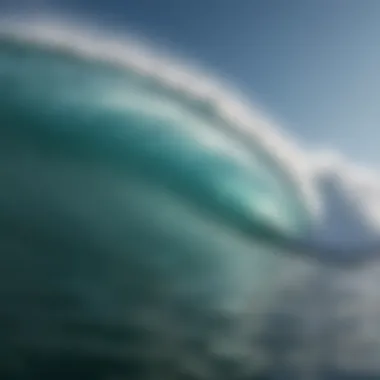

Understanding how geographical features influence swell is crucial for anyone involved with surfing. The coastline is not the same everywhere, and that diversity results in varied wave behavior. Key geographical elements like the continental shelf and seafloor topography play a significant role in shaping swell patterns. By delving into these factors, surfers can better predict and adapt to changing ocean conditions, ultimately enhancing their performance.
Continental Shelf and Its Impact on Wave Formation
The continental shelf can be seen as the underwater extension of a continent. This region slopes gently into the ocean and signsficantly influences wave characteristics as swells approach the shore. The shelf's width can determine how waves break, affecting both the size and the shape of the swell.
When swells travel over a wide continental shelf, they tend to develop more energy and take on a more defined shape. This is because the water depth gradually changes the swell's speed and height. Consequently, the interaction between the swell and the shelf often enhances the breaking power of waves as they near the shore. Surfers can capitalize on these conditions to find the best places to ride, often favoring areas where the shelf narrows.
Some additional factors influenced by the continental shelf include:
- Wave Refraction: As waves move into shallow waters, they slow down, causing them to bend. This process can concentrate energy on certain areas, creating excellent breaks for surfers.
- Bottom Contours: The shape of the seafloor, such as sandbars or rock formations on the continental shelf, can also determine how waves break. Surfers learn to recognize these subtleties when searching for optimal surfing spots.
Seafloor Topography and Swell Behavior
Seafloor topography refers to the physical features of the ocean floor, from valleys and mountains to plains and ridges. These undersea structures can dramatically influence swell behavior, impacting how the energy of the swell is distributed as it travels toward the shore.
Uneven seafloor formations can lead to various wave patterns. For example, if the seafloor rises sharply before the waves break, surfers might experience hollow waves, which are desirable for certain maneuvers. Conversely, a gradual slope could produce softer, slower waves, which may not be as exciting for dynamic surfing.
Moreover, specific features of the seafloor also create distinct types of breaks:
- Point Breaks: These occur when waves hit a point of land and bend around it, offering long, smooth rides for surfers.
- Reef Breaks: Found near coral reefs, these breaks can produce powerful waves that riders find thrilling. However, they can be dangerous due to shallow waters and sharp coral.
- Beach Breaks: These occur on sandy bottoms and are often more unpredictable, allowing for a variety of wave types as the swell hits different sand formations.
As each swell interacts with these geographical factors, surfers need to adapt their techniques and strategies. Being aware of how the continental shelf and seafloor topography shape swell behavior enhances a surfer's ability to read the ocean, leading to a more enriching surfing experience.
Types of Swell
In the oceanic tapestry, swell is not merely waves; it’s a complex interplay of forces shaping the very experience of surfing. Understanding the different types of swell becomes essential for anyone looking to ride the waves with skill and precision. Recognizing whether it’s a ground swell, wind swell, local swell, or distant swell can tilt the scales in favor of both safety and enjoyment for surfers, instructors, and even researchers in marine biology. The variances in swell types influence not just the height and power of waves but also their approach to the beach, impacting where and how surfers can best engage with the water.
Ground Swell vs. Wind Swell
Ground swell typically arises from distant storms, traveling great distances across the ocean. It’s like that slow-moving freight train, delivering energy continuously. These swells are characterized by longer intervals and more powerful waves, creating steep, clean faces that are often considered ideal conditions for surfing. The nature of ground swells—smooth and immensely powerful—provides a level of predictability that many surfers crave. Ground swells can maintain their shape and power even as they approach the shore, making them a favorite among experienced surfers who seek thrilling rides.
Conversely, wind swells are created by local winds stirring up the sea surface, often leading to shorter intervals and choppy waves. They have a more erratic behavior, resulting in less organized and more unpredictable conditions. Wind swells don't travel as far, and their energy dissipates quickly, leading to surf that can be fun for beginners but may be disappointing for those seeking the perfect wave.
Key Differences:
- Origin: Ground swells arise from distant storms, while wind swells are bred from local winds.
- Wave Characteristics: Ground swells tend to have longer wave periods• and steeper faces, making them more desirable for experienced surfers. Wind swells are shorter and often less organized, thus can be choppy.
- Consistency: Ground swells bring more consistent surf conditions over a longer period. Wind swells can vary from session to session with the changing wind patterns.
Both ground swells and wind swells play a role in the surfer's experience, offering distinct opportunities. Knowing when and where each type is likely to occur can drastically improve a surfer's ability to make the most of a session on the water.
Local vs. Distant Swell
The terms local and distant swell can seem straightforward but are key to understanding how geography and weather influence surf conditions. Local swells, just like their name implies, originate from nearby winds and storms. They tend to be affected by local topography, whether it's a beach crowded with jetty work or one aligned perfectly with the swells. These waves can vary significantly even within short distances along the coast; what’s working wonders at one shore might be lackluster just a few miles down.
Distant swell, on the other hand, travels from faraway storm systems, often propagating over huge distances in the ocean. This lengthy journey allows for a smoothing out of the wave energy, producing a more refined and powerful surf as it reaches the coast. Surfers often revel in larger, cleaner distant swells, relishing the opportunity they bring to experience longer rides and better wave placements.
Considerations:
- Local Swell:
- Distant Swell:
- More affected by nearby weather and geographic features.
- Can be inconsistent and sometimes choppy due to wind variations.
- Provides longer, more perfectly formed waves.
- Allows for a broader window of good surfing conditions at more than one beach along the coastline.
Understanding the differences between local and distant swells helps surfers adapt to changing conditions, optimizing their choice of surf spots. By keeping an eye on weather patterns and geographical features, surfers can enhance their time spent on the water, riding gleaming waves with confidence.
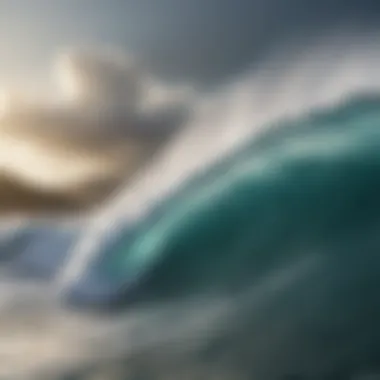

Ultimately, navigating different types of swell allows surfers to choose conditions that align with their skill levels and preferences, maximizing both safety and enjoyment.
This understanding aids in predicting surf conditions and empowers surfers to approach each session equipped with the knowledge necessary to make informed decisions while out on the waves.
Technological Advances in Swell Prediction
As surfers, comprehending the nature of swell is pivotal to maximizing the surfing experience. In today’s fast-paced world, technology has ushered in a new age of swell prediction that enhances our understanding of wave behavior. It helps surfers recognize when and where to catch the best waves, allowing them to make informed decisions. With tools and techniques evolving, the relationship between technology and swell forecasting is becoming stronger, offering both precision and accessibility to surfers of all skill levels.
Surf Forecasting Tools
Surf forecasting tools are at the forefront of swell prediction advancements. These tools assist in tracking various factors like wind speed, swell direction, and even tide phases. A prime example is the use of surf forecasting apps such as Magicseaweed and Surfline. They typically provide detailed reports that include a variety of metrics.
- Wind Speed: Understanding wind speed is crucial as it can shape the quality of the incoming waves.
- Swell Height: Tools help predict the height by analyzing historical data and current conditions.
- Swell Period: The time between waves can significantly impact the riding experience, as longer periods often translate to more powerful and better-formed waves.
These tools integrate data from buoys, weather stations, and local conditions, making it easier than ever for surfers to plan their sessions effectively. With these technological marvels, one can increase their chances of hitting the right waves at the right time.
Satellite Imagery and Its Uses
In the rapidly evolving realm of ocean observation, satellite imagery stands out as a game-changer. By providing a comprehensive view of ocean dynamics, it enables surfers to monitor swell patterns over vast distances.
- Real-time Monitoring: Satellites can capture real-time images of ocean conditions, allowing for quick assessments. This helps in judging how local surf conditions align with distant swell events.
- Wave Formation Analysis: By interpreting satellite data, scientists can analyze how different swells propagate and interact, leading to a better understanding of how waves break and behave upon reaching the shore.
The incorporation of satellite imagery into swell tracking equips surfers with an unprecedented advantage in terms of planning and ensuring a fruitful outing. This marriage of technology and oceanography is not only fascinating but also crucial for making well-informed decisions in the water. As we continue to explore the seas, these advances keep surfers ahead of the game, amplifying their skills and experiences.
Environmental Considerations
The relationship between surf conditions and environmental factors can't be overstated. Every surfer knows that waves are influenced by various elements beyond just wind and weather. This section dives into two significant aspects of environmental considerations: climate change and coastal development. Understanding these factors helps surfing enthusiasts stay informed about how natural systems are shifting and how these shifts impact their favorite pastime.
Climate Change and Its Effects on Swell Patterns
Climate change poses a serious threat to swell patterns and, consequently, to surfing itself. With rising global temperatures, we have started to see variations in wind patterns and ocean temperatures, both of which are crucial for swell generation. For instance, warmer ocean waters can lead to changes in storm formation, which hinders the traditional patterns of swell we’ve relied on for years.
- Altered Wind Patterns: Changes in atmospheric conditions influence how and where wind blows. As wind directions shift, so does the energy transfer to waves. Less consistent patterns can lead to unpredictability, making it harder for surfers to forecast good surf days.
- Storm Frequencies: The increase in storm intensity and frequency, particularly in certain regions, affects how swell propagates across the ocean. Stronger storms can generate larger and more powerful swells, but they may also result in unpredictable wave behavior as they disrupt existing ocean currents.
- Sea Level Rise: As sea levels continue to rise, the structure of beaches alters. Shifting shorelines can impact where and how waves break, which might change favorite surf spots entirely. The stability of these sites is paramount for consistent surfing experiences.
This shift in swell, driven by our changing climate, necessitates that surfers adapt their skills and approaches, staying flexible amid evolving environmental conditions.
Impact of Coastal Development on Wave Behavior
Coastal development is another critical factor that influences surf conditions. With urban sprawl and infrastructure development on the coasts, several key changes occur:
- Breakwater Construction: Those giant concrete structures meant to protect shorelines can inadvertently change local swell dynamics. They can block natural wave formation and redirect energy, creating inconsistent or even dangerous surf conditions.
- Beach Nourishment Projects: While designed to combat erosion, these projects often alter the natural beach profile. Adding sand can change wave shape and height, sometimes leading to less favorable surfing situations.
- Pollution and Water Quality: Environmental degradation from development can lead to increased pollution levels in the water. This not only affects marine life but also has implications for surfers' health. Polluted waters can pose risks after a good surf session, sometimes leaving surfers seeking refuge from their favorite spots.
Understanding these environmental considerations is essential for surfers, instructors, and anyone involved in watersports. By recognizing how climate change and coastal development impact swell, individuals can advocate for practices that protect the coastal environment and, by extension, their beloved surf culture.
Finale
In wrapping up our exploration of swell, it’s clear this concept holds significant sway in the surfing world. A grasp of swell dynamics — the causes and variances — directly feeds into a surfer's ability to catch and ride waves. Understanding how nature orchestrates the rise of swells grants surfers a better vantage point when choosing spots and times for optimal performance. This knowledge also reverberates in many areas, from safety to enjoyment on the water.
Summary of Key Causes of Swell
Recapping the key points discussed throughout the article unveils several crucial aspects that influence swell formation.
- Natural Elements: Wind patterns stir the surface of the ocean, which is often the initial brushstroke in the making of swell. The interplay of atmospheric conditions and marine geography can create a cascade of wave activity.
- Storm Systems: Storm systems act like chefs in a kitchen, concocting swells from the powerful forces of nature. These storms generate waves that travel vast distances, impacting surf spots far from their origin.
- Geographical Features: The shape of coastlines, the orientation of bays, and the structure of the seafloor play pivotal roles in how swells manifest as rideable waves. Each beach has its character, influenced by surrounding landforms.
In brushing up on these natural phenomenon, surfers gain awareness that can help one make smarter decisions when hitting the waves.
Implications for Surfing Practice
Understanding swell isn’t just a nice-to-have; it translates into real-world benefits in practice. For starters, surfers equipped with knowledge of swell dynamics can:
- Choose the Right Location: Knowing where and when swells hit guarantees a higher chance of finding good surf. Awareness of local spots that perform best during certain wind and swell conditions can make all the difference.
- Enhance Performance: Familiarity with swell types can aid surfers in selecting the right gear. Techniques mastered on ground swells versus wind swells can translate into better rides and fewer wipeouts.
- Prioritize Safety: Recognizing how different types of swells behave in conjunction with coastal conditions allows for a more informed approach to safety. This is particularly essential in an ever-changing environment where conditions can shift rapidly.





